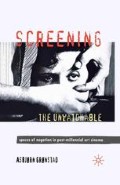Abstract
As critics and viewers of transgressive cinema, we are easily ensnared by a peculiar and quite possibly irresolvable conundrum. It goes like this: we are attracted to the cinema in no small part because it provides a particular experience, an aesthetic experience, that cannot be had elsewhere. Whatever the subject matter of the film, we trust that its form will act as a buffer against any anxiety or distress. Even the one filmmaker in the world most obsessively focused on punishing his audience, Michael Haneke, has acknowledged as much. “All important artworks, especially those concerned with the darker side of experience,” he muses, “despite whatever despair conveyed, transcend the discomfort of the content in the realization of their form.”1 That is the theory. Practical experience at the movies is another matter. In his review of Gaspar Noé’s Irréversible (2002), celebrated movie critic and connoisseur Roger Ebert begins by observing that the film is “so violent and cruel that most people will find it unwatchable.”2 Upon the film’s premiere in Cannes in the spring of 2002, 250 people left the theater, nauseated. Reporting from the Cannes festival seven years later, on May 17, 2009, Ebert’s writing is wound up, impassioned. He has just come out of a screening of Antichrist, the instantly notorious film by Lars Von Trier, which he rather glowingly describes as “an audacious spit in the eye of society.”3
Access this chapter
Tax calculation will be finalised at checkout
Purchases are for personal use only
Preview
Unable to display preview. Download preview PDF.
Notes
Quoted in Christopher Sharrett, “The World That is Known,” “The World that is known: Michael Haneke interviewed.” Kinoeye: New Perspectives on European Film 4.1 (2004): http://www.kinoeye.org/04/01/interview01.php. Accessed September 1, 2006.
Catherine Breillat, Pornocratie, Paris: Denoë 1, 2001.
Catherine Breillat, Anatomie de l’enfer, CB Films et al., 2004.
See for instance George Poulet’s concept of the “inhabitation of another,” in “Phenomenology of Reading,” New Literary History, 1 (1969): 55; Jonathan Culler’s notion of “dissolution,” in Structuralist Poetics: Structuralism, Linguistics and the Study of Literature, London: Routledge, 1975, 28; Norman Holland’s notion of the effaced self, in “Unity Identity Text Self,” Reader-Response Criticism: From Formalism to Post-Structuralism, ed. Jane P. Tompkins, Baltimore: Johns Hopkins University Press, 1980; Roland Barthes’s idea of “ecstatic loss,” in “Theory of the Text,” Untying the Text: A Post-Structuralist Reader, ed. Robert Young, Boston: Routledge, 1981, 32; and Wayne Booth’s suggestion that the text occupies the self, in The Company We Keep.
Richard Rushton, “Deleuzian Spectatorship,” Screen 50.1 (2009): 50. With regard to the theory of immersion, Rushton mentions the work of Oliver Grau, Ron Burnett, and Martin Rieser.
Brigitte Peucker, The Material Image: Art and the Real in Film, Stanford: Stanford University Press, 2007, 141.
Mary Ann Caws, The Art of Interference: Stressed Readings in Verbal and Visual Texts, Cambridge: Polity Press, 1989, 135; 136.
Ralph Waldo Emerson, Nature [1836], Boston & Cambridge: James Munroe & Company, 1849.
See Les Blank, dir., Burden of Dreams, Flower Films, 1982.
Richard Slotkin, “Dreams and Genocide: The American Myth of Regeneration Through Violence,” The Popular Culture Reader, eds. Jack Nachbar, Deborah Weiser, and John L. Wright, Bowling Green: Bowling Green University Popular Press, 1978, 52. See also Richard Slotkin, Regeneration Through Violence: The Mythology of the American Frontier, 1600–1860 [1973], Norman: University of Oklahoma Press, 2000.
Robert Frost, “Home Burial,” North of Boston, London: David Nutt, 1914. I owe this Observation to my colleague Øyvind Vågnes, who first brought up the poem in a conversation about Antichrist in Bergen on February 23, 2010.
This is Genette’s term. See Gérard Genette, Palimpsestes: La Littérature au Second Degré, Paris: Seuil, 1982, 356.
Martin Harries, Forgetting Lot’s Wife: On Destructive Spectatorship, New York: Fordham University Press, 2007, 9.
See Gaylyn Studlar, In the Realm of Pleasure: Von Sternberg, Dietrich and the Masochistic Aesthetic, Urbana: University of Illinois Press, 1988, 76.
Allan Cameron, “Contingency, Order, and the Modular Narrative: 21 Grams and Irréversible,” The Velvet Light Trap, 58 (2006): 71
Richard Slotkin, Gunfighter Nation: The Myth of the Frontier in Twentieth-Century America [1992, Norman: University of Oklahoma Press, 1998, 597.
J. W. Dunne, An Experiment With Time, London: A. & C. Black, 1927.
Arthur Schopenhauer, Essays and Aphorisms, sel. and trans. R. J. Hollingdale, London: Penguin Books, 1970, 51.
Leo Steinberg, Other Criteria: Confrontations with Twentieth-Century Art, London: Oxford University Press, 1972, 63.
W. K. Wimsatt & M. C. Beardsley, “The Affective Fallacy,” The Sewanee Review, 57:1 (1949): 31–55.
Copyright information
© 2012 Asbjørn Grønstad
About this chapter
Cite this chapter
Grønstad, A. (2012). Entropic Cinema, or Trouble Every Day. In: Screening the Unwatchable. Palgrave Macmillan, London. https://doi.org/10.1057/9780230355859_3
Download citation
DOI: https://doi.org/10.1057/9780230355859_3
Publisher Name: Palgrave Macmillan, London
Print ISBN: 978-1-349-32064-6
Online ISBN: 978-0-230-35585-9
eBook Packages: Palgrave Media & Culture CollectionLiterature, Cultural and Media Studies (R0)

